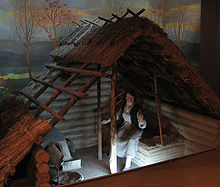Srubna culture
| Prehistoric cultures of Russia | |
| Mesolithic | |
| Kunda culture | 7400-6000 BC Chr. |
| Neolithic | |
| Bug Dniester culture | 6500-5000 BC Chr. |
| Dnepr-Don culture | 5000-4000 BC Chr. |
| Sredny Stog culture | 4500-3500 BC Chr. |
| Ekaterininka culture | 4300-3700 BC Chr. |
| Fatyanovo culture | around 2500 BC Chr. |
| Copper Age | |
| North Caspian culture | |
| Spa culture | 5000-3000 BC Chr. |
| Samara culture | around 5000 BC Chr. |
| Chwalynsk culture | 5000-4500 BC Chr. |
| Botai culture | 3700-3100 BC Chr. |
| Yamnaya culture | 3600-2300 BC Chr. |
| Afanassjewo culture | 3500-2500 BC Chr. |
| Usatovo culture | 3300-3200 BC Chr. |
| Glaskovo culture | 3200-2400 BC Chr. |
| Bronze age | |
| Poltavka culture | 2700-2100 BC Chr. |
| Potapovka culture | 2500-2000 BC Chr. |
| Catacomb tomb culture | 2500-2000 BC Chr. |
| Abashevo culture | 2500-1800 BC Chr. |
| Sintashta culture | 2100-1800 BC Chr. |
| Okunew culture | around 2000 BC Chr. |
| Samus culture | around 2000 BC Chr. |
| Andronovo culture | 2000-1200 BC Chr. |
| Susgun culture | around 1700 BC Chr. |
| Srubna culture | 1600-1200 BC Chr. |
| Colchis culture | 1700-600 BC Chr. |
| Begasy Dandybai culture | around 1300 BC Chr. |
| Karassuk culture | around 1200 BC Chr. |
| Ust-mil culture | around 1200–500 BC Chr. |
| Koban culture | 1200-400 BC Chr. |
| Irmen culture | 1200-400 BC Chr. |
| Late corporate culture | around 1000 BC Chr. |
| Plate burial culture | around 1300–300 BC Chr. |
| Aldy Bel culture | 900-700 BC Chr. |
| Iron age | |
| Baitowo culture | |
| Tagar culture | 900-300 BC Chr. |
| Nosilowo group | 900-600 BC Chr. |
| Ananino culture | 800-300 BC Chr. |
| Tasmola culture | 700-300 BC Chr. |
| Gorokhovo culture | 600-200 BC Chr. |
| Sagly bashi culture | 500-300 BC Chr. |
| Jessik Beschsatyr culture | 500-300 BC Chr. |
| Pazyryk level | 500-300 BC Chr. |
| Sargat culture | 500 BC Chr. – 400 AD |
| Kulaika culture | 400 BC Chr. – 400 AD |
| Tes level | 300 BC Chr. – 100 AD |
| Shurmak culture | 200 BC Chr. – 200 AD |
| Tashtyk culture | 100–600 AD |
| Chernyakhov culture | AD 200–500 |

The Srubna or bar grave culture ( Ukrainian: Зрубна культ́ура, Russian: Срубная культура) was a late Bronze Age culture of the 20th to 12th century BC. It is a successor to the late catacomb tomb culture , as well as the Poltavka, Potapovka and Pokrovsk groups. The name was coined in the first description in 1901 after the typical overbuilding of the graves by log huts (Russian сруб , adjective cрубная ).
The Srubna culture was distributed roughly along and above the northern shore of the Black Sea , from the Dnepr eastward along the northern edge of the Caucasus to the northern coast of the Caspian Sea , while still crossing the Volga , to the neighboring, roughly simultaneous and related Andronovo -Culture .
At the burials there were also animal parts that were added to the graves. The bearers of the Srubna culture lived on agriculture and livestock .
The Srubna culture was joined in the first millennium BC by cultures that already belonged to the environment of the historically first tangible Kimmerer .
literature
- James P. Mallory : Srubna Culture. In: James P. Mallory, Douglas Q. Adams (Eds.): Encyclopedia of Indo-European Culture. Fitzroy Dearborn, London et al. 1997, ISBN 1-884964-98-2 .
- Henri-Paul Francfort: The Archeology of Protohistoric Central Asia and the Problems of Identifying Indo-European and Uralic-Speaking Populations. In: Christian Carpelan, Asko Parpola, Petteri Koskikallio (Eds.): Early Contacts between Uralic and Indo-European. Linguistic and Archaeological considerations (= Suomalais-Ugrilaisen Seuran Toimituksia. Vol. 242). Papers presented at an international Symposium held at the Tvärminne Research Station of the University of Helsinki, January 8-10, 1999. Suomalais-Ugrilainen Seura , Helsinki 2001, ISBN 952-5150-59-3 , pp. 151-168.
Web links
- Marion Linska, Andrea Handl, Gabriele Rasuly-Paleczek: Introduction to the ethnology of Central Asia. ( Memento from September 9, 2006 in the Internet Archive ) (PDF; 619 kB; 129 pp.) Lecture script , Vienna January 2003 (accessed on June 16, 2013), Info: Rasuly-Paleczek is now an assistant professor at the Institute for Culture - and social anthropology from the University of Vienna.
Individual evidence
- ↑ The dates in the table are taken from the individual articles and do not always have to be reliable. Cultures in areas of other former Soviet republics were included.
- ↑ L. Koryakava, AV Epimakhov 2007, The Urals and Western Siberia in the Bronze and Iron Ages, TABLE 0.4
- ↑ The German and English name formation Srubna culture happened in ignorance of the Russian language, since the word srubna does not exist there, but it is a mutilation of the female adjective srubnaja . In Ukrainian, it is the correct adjectival form in transcription. The correct German form would be Srub-Kultur or the translation.

